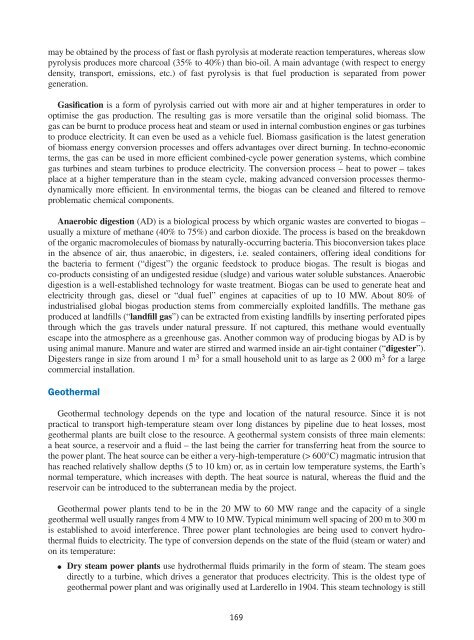Projected Costs of Generating Electricity - OECD Nuclear Energy ...
Projected Costs of Generating Electricity - OECD Nuclear Energy ...
Projected Costs of Generating Electricity - OECD Nuclear Energy ...
Create successful ePaper yourself
Turn your PDF publications into a flip-book with our unique Google optimized e-Paper software.
may be obtained by the process <strong>of</strong> fast or flash pyrolysis at moderate reaction temperatures, whereas slow<br />
pyrolysis produces more charcoal (35% to 40%) than bio-oil. A main advantage (with respect to energy<br />
density, transport, emissions, etc.) <strong>of</strong> fast pyrolysis is that fuel production is separated from power<br />
generation.<br />
Gasification is a form <strong>of</strong> pyrolysis carried out with more air and at higher temperatures in order to<br />
optimise the gas production. The resulting gas is more versatile than the original solid biomass. The<br />
gas can be burnt to produce process heat and steam or used in internal combustion engines or gas turbines<br />
to produce electricity. It can even be used as a vehicle fuel. Biomass gasification is the latest generation<br />
<strong>of</strong> biomass energy conversion processes and <strong>of</strong>fers advantages over direct burning. In techno-economic<br />
terms, the gas can be used in more efficient combined-cycle power generation systems, which combine<br />
gas turbines and steam turbines to produce electricity. The conversion process – heat to power – takes<br />
place at a higher temperature than in the steam cycle, making advanced conversion processes thermodynamically<br />
more efficient. In environmental terms, the biogas can be cleaned and filtered to remove<br />
problematic chemical components.<br />
Anaerobic digestion (AD) is a biological process by which organic wastes are converted to biogas –<br />
usually a mixture <strong>of</strong> methane (40% to 75%) and carbon dioxide. The process is based on the breakdown<br />
<strong>of</strong> the organic macromolecules <strong>of</strong> biomass by naturally-occurring bacteria. This bioconversion takes place<br />
in the absence <strong>of</strong> air, thus anaerobic, in digesters, i.e. sealed containers, <strong>of</strong>fering ideal conditions for<br />
the bacteria to ferment (“digest”) the organic feedstock to produce biogas. The result is biogas and<br />
co-products consisting <strong>of</strong> an undigested residue (sludge) and various water soluble substances. Anaerobic<br />
digestion is a well-established technology for waste treatment. Biogas can be used to generate heat and<br />
electricity through gas, diesel or “dual fuel” engines at capacities <strong>of</strong> up to 10 MW. About 80% <strong>of</strong><br />
industrialised global biogas production stems from commercially exploited landfills. The methane gas<br />
produced at landfills (“landfill gas”) can be extracted from existing landfills by inserting perforated pipes<br />
through which the gas travels under natural pressure. If not captured, this methane would eventually<br />
escape into the atmosphere as a greenhouse gas. Another common way <strong>of</strong> producing biogas by AD is by<br />
using animal manure. Manure and water are stirred and warmed inside an air-tight container (“digester”).<br />
Digesters range in size from around 1 m 3 for a small household unit to as large as 2 000 m 3 for a large<br />
commercial installation.<br />
Geothermal<br />
Geothermal technology depends on the type and location <strong>of</strong> the natural resource. Since it is not<br />
practical to transport high-temperature steam over long distances by pipeline due to heat losses, most<br />
geothermal plants are built close to the resource. A geothermal system consists <strong>of</strong> three main elements:<br />
a heat source, a reservoir and a fluid – the last being the carrier for transferring heat from the source to<br />
the power plant. The heat source can be either a very-high-temperature (> 600°C) magmatic intrusion that<br />
has reached relatively shallow depths (5 to 10 km) or, as in certain low temperature systems, the Earth’s<br />
normal temperature, which increases with depth. The heat source is natural, whereas the fluid and the<br />
reservoir can be introduced to the subterranean media by the project.<br />
Geothermal power plants tend to be in the 20 MW to 60 MW range and the capacity <strong>of</strong> a single<br />
geothermal well usually ranges from 4 MW to 10 MW. Typical minimum well spacing <strong>of</strong> 200 m to 300 m<br />
is established to avoid interference. Three power plant technologies are being used to convert hydrothermal<br />
fluids to electricity. The type <strong>of</strong> conversion depends on the state <strong>of</strong> the fluid (steam or water) and<br />
on its temperature:<br />
● Dry steam power plants use hydrothermal fluids primarily in the form <strong>of</strong> steam. The steam goes<br />
directly to a turbine, which drives a generator that produces electricity. This is the oldest type <strong>of</strong><br />
geothermal power plant and was originally used at Larderello in 1904. This steam technology is still<br />
169

















